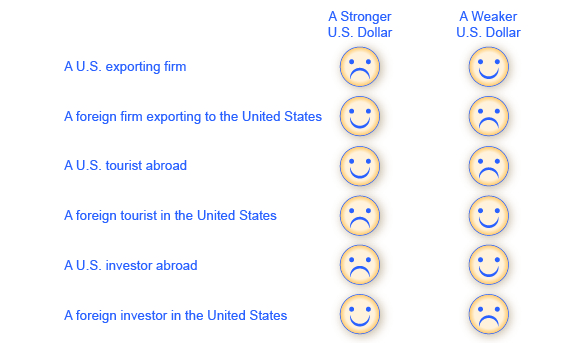Chapter 18: Exchange Rate and Trade Finance
18.2 Appreciation and Depreciation of Currencies
Foreign exchange market involves multiple currencies being exchanged between multiple participants. When the prices of most goods and services change, the price “rises” or “falls.” For exchange rates, the terminology used is different.
When the exchange rate for a currency rises, so that the currency exchanges for more of other currencies, we say that it is appreciating or “strengthening.” When the exchange rate for a currency falls, so that a currency trades for less of other currencies, we say that it is depreciating or “weakening.”
Think About It! Foreign Exchange
Watch this video to learn more about exchange rates, appreciation and depreciation of currency and the factors that cause supply and demand to shift.
Video: Foreign Exchange
Source: Jacob Clifford. (2012, May 10). The foreign exchange market – macro 6.3 [Video]. YouTube. https://youtu.be/D41EuDh3epI?si=5lbuV7pvxOEePN1E
Test Yourself
Currency appreciation and depreciation will have a different meaning for different foreign exchange market participants. Currency appreciation may mean a profit for the exporter but a loss for the importer. Likewise, it will play differently for an investor and for a visitor. In trade finance, where buyers and sellers of currency are not always intuitively obvious, it makes sense to trace how different participants will be affected by a stronger or weaker currency. Let’s brainstorm with the activity below to understand the impact of currency appreciation and depreciation on participants in the foreign exchange market.
Think About It! U.S. Dollar
Figure 18.1 summarizes the impact of a stronger U.S. dollar on six different players the in the foreign exchange market.

Let’s think about why these different market players are happy or sad. Who is benefiting from U.S. dollar appreciation and who is losing from it?
Attributions
“Think About It! U.S. Dollar” is adapted from Module 16: Exchange Rates and International Finance: Strengthening and Weakening Currency, in Macroeconomics, provided by Lumen Learning under a CC BY-SA: Attribution-ShareAlike license.
“Figure 18.1: Affect of Changes in the U.S. Dollar Exchange Rate” is reused from “Figure 2. How Do Exchange Rate Movements Affect Each Group?” in Module 16: Exchange Rates and International Finance: Strengthening and Weakening Currency, in Macroeconomics, provided by Lumen Learning under a CC BY-SA: Attribution-ShareAlike license.
Image Descriptions
Figure 18.1: Affect of Changes in the U.S. Dollar Exchange Rate
The image is a chart comparing the effects of a stronger U.S. dollar versus a weaker U.S. dollar on various entities. The chart is divided into three columns. The first column lists six market players involved in international economic activities, each row containing a different entity. The middle column, titled “A Stronger U.S. Dollar,” contains a series of graphical representations of sad and happy faces for each market player. The right column, titled “A Weaker U.S. Dollar,” contains corresponding sad and happy faces. The market players and the faces are listed in the table below.
| Market Player | A Stronger U.S. Dollar | A Weaker U.S. Dollar |
|---|---|---|
| A U.S. exporting firm | Sad face | Happy face |
| A foreign firm exporting to the United States | Happy face | Sad face |
| A U.S. tourist abroad | Happy face | Sad face |
| A foreign tourist in the United States | Sad face | Happy face |
| A U.S. investor abroad | Sad face | Happy face |
| A foreign investor in the United States | Happy face | Sad face |
[back]

